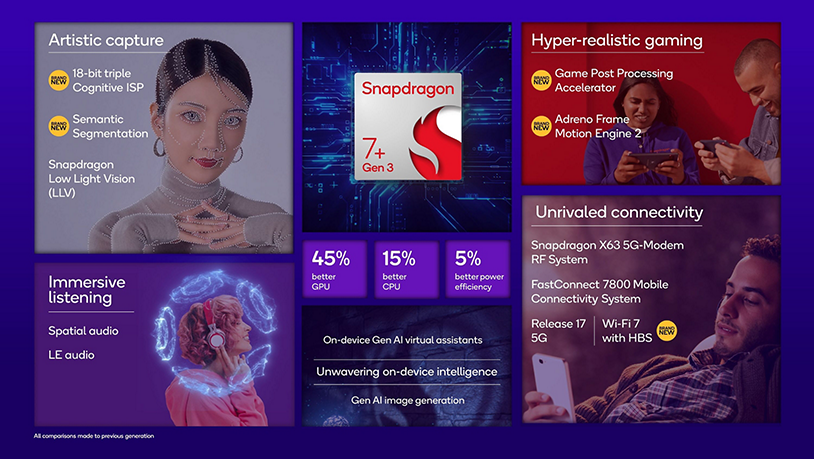
A new dawn of flagship killers might be on the horizon, powered by Qualcomm's new Snapdragon 7 Plus Gen 3. This new chipset doubles down on the company's focus on AI, further integrating on-device generative AI and could power smarter mid-range phones capable of challenging their powerful flagship counterparts.
Qualcomm says the Snapdragon 7 Plus Gen 3 offers significant improvements by expanding the AI features brought by the previous Snapdragon 7 series, including some of the advanced AI technology from the premium Snapdragon 8 Gen 3, used in some of the best Android phones seen this year so far. These enhancements incorporate improved photography features, advanced gaming technology, and support for a wide range of AI models.
While cloud-based AIs like Chat GPT can handle complex tasks, they need a constant internet connection to work. However, on-device AI, which recent high-end Snapdragon chips can power, is better for tasks like voice and image recognition, natural language processing, and providing smart filters in photo editing apps. Onboard AI can also provide more practical day-to-day improvements to performance and longer battery life by fine-tuning software and running apps, predicting battery health and optimizing charging.
With the Snapdragon 7 Plus Gen 3, Qualcomm notes on-device AI can generate original pictures or text and enhance users' AI assistant and provide faster and more accurate language translation than before.

The new chip’s AI integration can also improve photography. The 18-bit cognitive Image Signal Processor (ISP) uses something called ‘semantic segmentation’, which uses AI to identify specific elements in a scene, such as faces, clothing, and backgrounds. It then enables individual optimization of each element's color, tone, sharpness, and noise reduction.
The Snapdragon 7 Plus Gen 3 also now supports 18-bit color instead of 12-bit, offering a wider range of displayed colors, creating smoother gradients, subtler variations, and more realistic photos.
Levelled-up gaming
Built on a 4-nanomerer process node, the new Snapdragon 7 Plus Gen 3 provides a 15% improvement in CPU performance and a 5% improvement in power efficiency, compared to its predecessor. The chip boasts a high-performance Cortex-X4 CPU running at 2.8 GHz, supported by four performance and three efficiency cores. Gamers will note that the Snapdragon 7 Plus Gen 3’s Adreno GPU offers a 45% performance boost over last year's model.
Get daily insight, inspiration and deals in your inbox
Sign up for breaking news, reviews, opinion, top tech deals, and more.
The Snapdragon 7 Plus Gen 3 will bring over select Snapdragon Elite Gaming features used in the latest Snapdragon 8 Gen 3. These include cinematic effects like bloom, depth of field, and motion blur to provide what Qulcoom claims to be “desktop-level visuals.” Qualcomm also says its Adreno Frame Motion Engine 2.0 feature allows frame rates to be doubled from 60 to 120 FPS without impacting battery life.
Thanks to the addition of Wi-Fi 7 support, the Snapdragon 7 Plus Gen 3 can achieve download speeds up to 5.8Gbps, almost doubling the previous model. While its X63 5G modem is only slightly behind this with a max speed of 4.2Gbps. The faster internet speeds ensure responsiveness and eliminate stutters for a smoother gaming experience.
Gamers and non-gamers alike will also benefit from the chip’s optimization for low-latency smartphone-to-earbud sound and improved spatial audio, which supports head tracking, making games and films more immersive.
What could it mean for mid-range phones?
Qualcomm announced that OnePlus, Realme, and Sharp will be the first devices to use the new Snapdragon 7 Plus Gen 3 chip, and are expected to be announced in the coming months.
AI advancements like those implemented on the Snapdragon 7 Plus Gen 3 could potentially revolutionize mid-range smartphones and bring them out of the shadow of phones with premium chips. Including AI could enhance performance, photography, gaming, and productivity, challenging flagship dominance.
Extending AI enhancements in mid-range devices could provide tools like real-time translation, note-taking, personalized recommendations and intelligent automation to a broader audience, potentially lowering the barrier to entry to AI tools, which could benefit those with limited access to premium devices.
At the very least, AI becoming more widely spread into mid-range phones will bring flagship-like intelligent features to more people at a more affordable price.
You may also like
James Ide was a writer for TechRadar specializing in phones and tablets, having previously worked at The Daily Mirror since 2016, covering news and reviews.
James loves messing with the latest tech, especially phones due to their incredibly rapid pace of development.
When not surrounded by various devices and/or tinkering with gadgets while putting them through their paces, James has a love of handheld consoles.
He is almost the textbook definition of a geek, who loves sci-fi, comics, games and of course, all things tech. If you think you have a story for him or just want to challenge him at Smash Bros, get in touch.